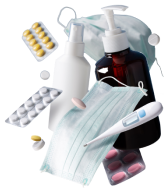Healthwire Pharmacy provides 100% genuine medicines straight to your doorstep.
Order Now! & Avail
Upto 10% OFF On All Your Pharmacy Orders!
Cephradine 250mg
Healthwire Pharmacy Ratings & Reviews (1500+)
Product Information
Cephradine is a first-generation cephalosporin antibiotic that exerts its bactericidal effect by inhibiting the synthesis of the bacterial cell wall. It specifically targets penicillin-binding proteins (PBPs) in susceptible bacteria, leading to the disruption of cell wall formation and ultimately causing cell lysis. Cephradine binds to PBPs, preventing the cross-linking of peptidoglycan strands, which are essential for maintaining the structural integrity of the bacterial cell wall. This interference weakens the cell wall, resulting in osmotic instability and cell death. The mechanism of action of Cephradine is similar to that of other cephalosporins, and it is effective against a range of Gram-positive and some Gram-negative bacteria.
Cephradine 250mg
Cephalosporin antibiotic
Injection
The following are the uses of Cephradine 250mg injection:
Tailoring Treatment for Optimal Health, Prescribed Medication Dosage is:
• Here are the common uses of Ceftriaxone Sodium for different health issues-
In the case of an overdose of Cephradine 250mg injection, seek medical assistance promptly. Symptoms may include nausea, vomiting, diarrhea, and in severe cases, seizures or an allergic reaction. Quick action is vital, as prompt medical intervention can effectively manage these symptoms and prevent potential complications. Timely treatment ensures the best possible outcome and minimizes the impact of the overdose.
In the case of a missed dose of Cephradine 250mg injection, it is important to administer the medication as soon as you remember. However, if it is almost time for the next scheduled dose, it is best to skip the missed dose and continue with the regular dosing schedule. Do not double the dose to make up for a missed one. If you have missed multiple doses, consult your healthcare professional for guidance on how to proceed, as they can provide specific instructions based on your medical history and the reason for your prescription.
To administer the Cephradine 250mg injection, clean the injection site, insert the needle at a 90-degree angle, and inject the medication slowly, ensuring the entire dose is delivered intramuscularly or intravenously as directed by your healthcare provider.
Following are the conditions when Cephradine 250mg injection should not be administered:
The side effects of Cephradine 250mg injection may include:
Following are the precautions and warnings for Cephradine 250mg Injection:
Following are the drug interactions for Cephradine 250mg injection:
Following are the food interactions to be aware of when using Cephradine 250mg injection:
Cephradine 250mg injection should be stored in a controlled environment, preferably in a cool and dry place, ensuring the temperature remains between 68°F and 77°F (20°C and 25°C). Protect the injection from direct sunlight, as it can degrade the medication. Always keep the medication in its original packaging, ensuring the seal is intact to maintain its sterility. Dispose of any unused or expired injections promptly, but do not throw them into the regular trash or pour them down the drain. Contact your healthcare provider or pharmacist for guidance on safe disposal methods to protect the environment. Keep this medication out of children's reach to prevent accidental exposure or ingestion.
Following are the quick tips for Cephradine 250mg injection:
When ceftriaxone sodium is administered to treat a range of bacterial infections, specific laboratory tests may be required to safely and effectively monitor the therapeutic response and for adverse effects. These tests are crucial because they aid in assessing the patient's overall health, the severity of the infection, and the medication's impact on vital organs. Moreover, they can identify potential drug interactions and any underlying medical conditions that may affect drug metabolism. Before starting treatment, preliminary tests are performed to serve as a baseline for the patient's normal physical parameters. These tests include blood work, cultures of infection sites, and images of affected areas. Cultures help determine the type of bacteria causing the infection, and images of infection sites help the clinician monitor healing over time. During the course of treatment, periodic laboratory assessments are prescribed to monitor potential adverse effects. These tests include:
Get Upto 10% discount on all items.

Order Now! & Avail
Upto 10% OFF On All Your Pharmacy Orders!

If you face any issue, feel free to contact us. We provide 24/7 support to assist your problems